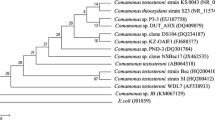Abstract
Gram-positive, non-spore-forming, non-acid-fast, rod-shaped aerobic bacteria with the ability to desulfurize dibenzothiophene (DBT) or dibenzosulfone (DBTO2) were isolated from soil samples contaminated with fossil fuels. Using a bioavailability method, cells with the desired DbtS+ phenotype were enriched. Modified fluorescence and colorimetric assays were used for the initial detection of 2-hydroxybiphenyl (OH-BP) in microtiter plates; subsequently, isolates were grown in wells of microtiter plates and screened for the production of desulfurization product. Fluorescence under UV light and the production of colored product in the phenol assay were used as presumptive indications of production of OH-BP. Confirmation of the presence of OH-BP was achieved with HPLC, UV-absorbance, and mass spectrometry. Nutrient utilization and fatty acid composition (as discerned with Biolog plates and gas chromatography, respectively) were used to identify presumptively the strains as Rhodococcus erythropolis; colony and cell morphology may not be consistent with the identification achieved by nutrient utilization and fatty acid composition. The desulfurization end product, OH-BP, can not be used as carbon source by the tested strain, N1-36.
Similar content being viewed by others
References
Afferden M van, Schacht S, Klein J (1990) Degradation of dibenzothiophene by Brevibacterium sp. DO. Arch Microbiol 153: 324–329.
Dahlberg MD (1992) Biodesulfurization of dibenzothiophene sulfone by a species of Arthrobacter and studies on biodesulfurization of oxidized coal. In: Yunker SB (ed) Third International Symposium on the Biological Processing of Coal, section 1, p 10.
Doetsch RN (1981) Determinative methods of light microscopy. In: Coordinating ed. Manual of methods for general bacteriology, chapt. 3. American Society for Microbiology, Washington DC, pp 26–30.
Ember L (1990) Clean Air Act: Congress Passes Massive Overhaul. Chem Engng News 68: 4–5.
Emerson E, Beacham HH, Beegle LC (1943) The condensation of aminoantipyrene II. A new color test for phenolic compounds. J Org Chem 8: 417–428.
Guirard BM, Snell EE (1981) Biochemical factors in growth. In: Coordinating ed. Manual of methods for general bacteriology, chapt. 7. American Society for Microbiology, Washington DC, p 98.
Goodfellow M (1986) Nocardioforms. In: Bergey's manual of systematic bacteriology, vol 2, Sect. 17. Williams & Wilkins. Baltimore London Los Angeles, pp 1472–1478.
Hessley RK, Reasoner JW, Riley JT (1986) Coal science. Wiley, New York, pp 183–220.
Isbister J (1986) Biological removal of organic sulfur from coal. In: McIlwain M (ed) Proceedings of Biological Treatment of Coals Workshop. Sheladia Associates, Rockville, MD, p 18.
Kilbane II JJ (1991) Molecular biological enhancement of coal biodesulfurization. Proceedings of Seventh Annual Coal Preparation, Utilization, and Environmental Control Contractors Conference. U.S. Department of Energy, Pittsburgh Energy Technology Center, pp 375–381.
Krawiec S (1990) Bacterial desulfurization of thiophenes: screening techniques and some speculations regarding the biochemical and genetic bases. In: Pierce GE (ed) Developments in industrial microbiology, vol 31. Society for Industrial Microbiology, pp 103–114.
Li J-K, Humphrey AE (1991) Use of fluorometry for monitoring and control of bioreactors. Biotechnol Bioeng 37: 1043–1049.
Wang P (1992) Isolation and characterization of bacterial strains capable of desulfurizing sulfur from some thiophenic compounds found in coal. Ph.D. dissertation, Lehigh University, Bethlehem, PA.
Whitehurst DD (1978) A primer on the chemistry and constitution of coal. In: Larsen JW (ed) Organic chemistry of coal. ACS Symposium Series 71. American Chemical Society, Washington DC, pp 1–35.
Yang R-D (1975) Kinetic study of phenol bio-degradation in pure and mixed cultures. Ph.D. dissertation. University of Pennsylvania, Philadelphia, pp 33–37.
Author information
Authors and Affiliations
Rights and permissions
About this article
Cite this article
Wang, P., Krawiec, S. Desulfurization of dibenzothiophene to 2-hydroxybiphenyl by some newly isolated bacterial strains. Arch. Microbiol. 161, 266–271 (1994). https://doi.org/10.1007/BF00248703
Received:
Accepted:
Issue Date:
DOI: https://doi.org/10.1007/BF00248703




